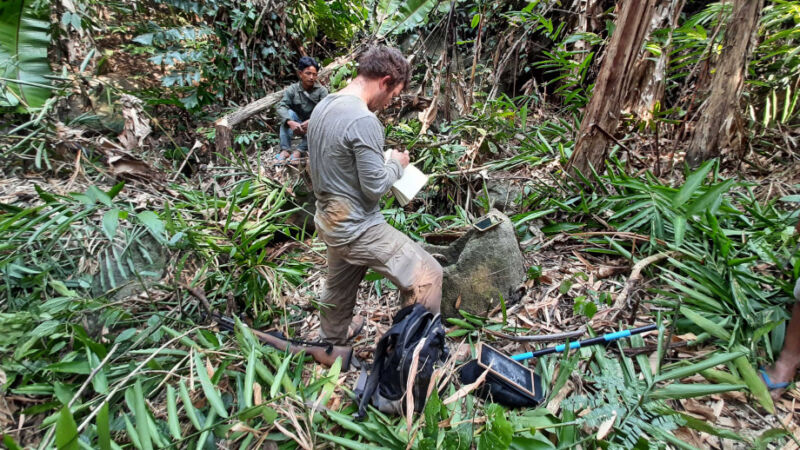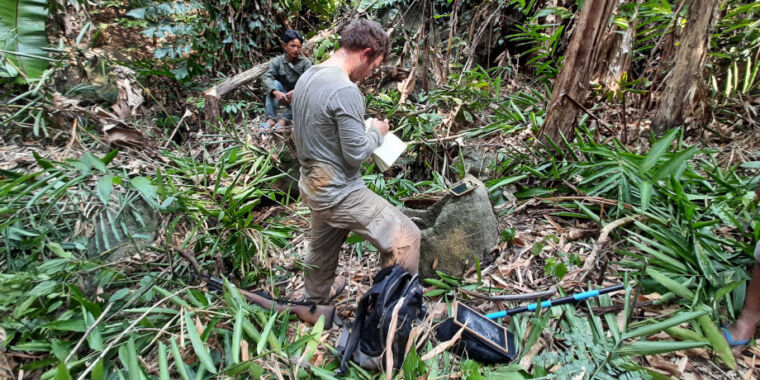
Nicholas Skopal
Hundreds of huge stone jars lie partially buried on hillsides and ridges in northeastern India. A recent survey found 65 jars at four previously undocumented sites, and the survey’s leaders say there are probably many more sites still hidden in the area’s mountainous forests. The jars are part of a whole landscape of megaliths carved by an ancient Indian culture which—so far—archaeologists know little about.
Enormous burial urns
Sometime in India’s ancient past, people carved giant jars, some up to two meters wide and three meters tall, from solid sandstone blocks. They transported the jars to hillsides and ridges and lined them up carefully, with a good view of the lowlands. Today, hundreds of those jars are in various states of disrepair, spread across a 300 square kilometer swath of Assam, a state in northeast India.
Archaeologists say the jars are probably massive burial urns, but almost nothing is known about the people who made them. It’s not even clear exactly how old the jars are, because the types of dating that could provide that information haven’t been done yet. “We still don’t know who made the giant jars or where they lived,” said Australian National University archaeologist Nicholas Skopal, a co-author of the recent paper, in a statement. “It seems as though there aren’t any living ethnic groups in India associated with the jars.”
The Naga people who lived in the area in the 1930s told a visiting anthropologist about a “lost people” they called the Siemi, who had made jars to hold the remains of their dead. Apparently the Siemi buried their dead with beads and iron objects; the Naga reported that their ancestors used to search the jars for those objects. In the process, they also found cremated human remains.
Archaeologists, led by Tilok Thakuria of North Eastern Hill University and Uttam Bathari of Gauhati University, recently surveyed two areas of dense tropical forest in Assam. They found four jar sites that had lain forgotten since their unknown makers left them behind (or since the ancestral Naga last looted them). That brings the number of jar sites in India to 11, with nearly 800 jars among them. And Thakuria, Bathari, and their colleagues say more are probably waiting to be rediscovered.
When in doubt, it’s probably ceremonial
As enigmatic as the jars themselves are, they’re just one part of a whole landscape of carved stone that archaeologists don’t yet fully understand. Thakuria, Bathari, and their colleagues say it shows “startling complexity and wide distribution.”
Some of Assam’s megaliths are flat circles of stone, about 70 cm to 80 cm wide and carved with human figures and geometric shapes. Archaeologists surveying the sites since 2014 have found these carved discs arranged in “lattice formations,” usually a few hundred meters away from a cluster of jars. And alongside many of the jars lie rectangular stone slabs, about a meter long and half that wide, with curved tops and human figures carved into their fronts.
Archaeologists still aren’t sure exactly what significance the carved sandstone discs and slabs once held for the people who crafted them and transported them to the hillsides of Assam. There’s a running joke among archaeologists that if you can’t figure out what an object was for, it’s probably something ceremonial. But in this case, it’s no joke—Thakuria, Bathari, and their colleagues suggest “some ritual connection between all three features” since they’re arranged so close together and in such consistent ways.
But the different types of carved stones—discs, slabs, and jars—may have been crafted and installed in different phases as the sites grew, similar to the thousands of years of change and growth that produced Stonehenge in the UK. A type of dating called optically stimulated luminescence, which measures how long it’s been since a chunk of stone was exposed to sunlight, could help reconstruct a timeline for Assam’s megaliths.
-
Jars at a site near Herakilo village.
Tilok Thakuria -
Jars at a site near Loungmailai village.
Tilok Thakuria -
Jars at a site called Thamodholing.
Tilok Thakuria -
Jars at a site called Lower Chaikam.
Tilok Thakuria -
One of the engraved stone discs; this one is marked with a four-pointed star.
Tilok Thakuria -
A broken rectangular stone slab.
Tilok Thakuria -
A broken piece of a rectangular stone slab, engraved with a female figure.
Tilok Thakuria








